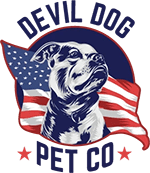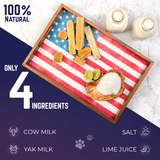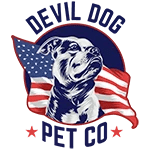Key Takeaways
- Choosing dog treats for sensitive stomachs requires careful assessment and understanding of your dog's digestive needs.
- Digestive issues in dogs are signals that you need to adjust your treat choices and approach.
- Applying disciplined, tactical methods helps in selecting the right treats for dogs with sensitive stomachs.
- Effective management of your dog's diet mirrors the precision and leadership skills used in the military.
Table of Contents
- Understanding Sensitive Stomachs in Dogs – What Every Responsible Owner Needs to Know
- How Your Dog's Digestive System Works (And Why It's So Easy to Disrupt)
- Key Ingredients to Seek (and Avoid) in Dog Treats for Sensitive Stomachs
- Limited-Ingredient, Hypoallergenic & Probiotic Treats, Which Works Best?
- The Role of Natural Chews (Yak Chews, Antlers, Bully Sticks) for Sensitive Stomachs
- Commercial Dog Treats for Sensitive Stomachs: Brand & Product Analysis (2025 Update)
- Homemade Dog Treats for Sensitive Stomachs: Practical Recipes and Tips
The Marine's Guide to Dog Treats for Sensitive Stomachs, Discipline Meets Digestive Care
When your dog's stomach rebels against every treat you offer, it's not just frustrating, it's a leadership test. Dog treats for sensitive stomachs require the same tactical precision we applied in the Corps: assess the situation, identify the root cause, execute with discipline. Your pup's digestive distress isn't a character flaw, it's intel telling you to change your approach.
As Marines, we learned that half-measures get people hurt. The same applies to your dog's gut health. Throwing random "gentle" treats at the problem without understanding why Fido's system is compromised will keep you both miserable. This guide cuts through the marketing noise to deliver actionable intelligence on selecting, introducing, and monitoring treats that work for dogs with finicky digestive systems.
For dogs with sensitive stomachs, natural chews like split elk antlers can provide long-lasting enrichment without overwhelming their digestive systems. Choosing the right chew is just as important as the treats themselves, especially when your dog needs both stimulation and gentle ingredients.
Download the FREE 10-Step Dog Prep Guide
Understanding Sensitive Stomachs in Dogs – What Every Responsible Owner Needs to Know
A sensitive stomach isn't a medical diagnosis, it's a pattern of digestive reactions that signal your dog's system can't handle certain ingredients, textures, or feeding protocols. Symptoms range from loose stools and excessive gas to vomiting, reluctance to eat, and persistent lip-licking after treats.
The root causes span genetics (some breeds are hardwired for GI sensitivity), stress, food allergies, sudden diet changes, and poor-quality ingredients that overwhelm the digestive tract. German Shepherds, Golden Retrievers, and Boxers show higher rates of food sensitivities, but any dog can develop stomach issues from inconsistent feeding or low-grade treats loaded with fillers.
Shelter Reality Check: Digestive issues contribute to 23% of owner surrenders according to ASPCA data. Most cases are preventable through disciplined treat selection and consistent monitoring, classic owner accountability failures.
Recognition is your first tactical advantage. Watch for vomiting within 2-6 hours of treating, loose stools the next morning, excessive drooling during or after chewing, and behavioral changes like hiding or restlessness. If these symptoms appear twice in one week, stop all treats immediately and reassess your strategy.
How Your Dog's Digestive System Works (And Why It's So Easy to Disrupt)

Your dog's digestive tract processes food in 8-10 hours compared to humans' 24-72 hours. This rapid transit means treats hit the system fast and hard, any inflammatory ingredient triggers immediate consequences. The canine stomach produces more acid than ours, but the intestinal lining is more delicate and reactive to foreign proteins.
Common GI irritants include dairy (most adult dogs are lactose intolerant), wheat gluten, corn syrup, artificial preservatives like BHA/BHT, and high-fat content above 15% per serving. Even "natural" treats can cause trouble if they contain multiple protein sources or unfamiliar starches that stress enzyme production.
| Digestive Factor | Dogs | Humans | Sensitivity Impact |
|---|---|---|---|
| Transit Time | 8-10 hours | 24-72 hours | Faster reactions to problem ingredients |
| Stomach pH | 1.5-2.0 | 1.5-3.5 | More acidic but less buffering capacity |
| Enzyme Diversity | Limited | Extensive | Struggles with complex ingredient lists |
Your stomach-proofing tactics: read ingredient lists like intelligence reports (fewer ingredients = lower risk), verify single protein sources, and calculate treat calories, they shouldn't exceed 10% of daily intake. When in doubt, simpler wins. For a deeper dive into the benefits of single-ingredient options, see single-ingredient dog treats: a comprehensive guide to healthy snacking.
Key Ingredients to Seek (and Avoid) in Dog Treats for Sensitive Stomachs
Highly digestible proteins form your foundation: single-source options like salmon, lamb, venison, or duck process easier than multi-protein blends. Novel proteins work best for dogs with established sensitivities, if your pup reacts to chicken, switch to rabbit or fish-based treats rather than another poultry variant.
Gut-friendly additions include prebiotics like pumpkin and sweet potato that feed beneficial bacteria, probiotics that restore digestive balance, and natural anti-inflammatories like turmeric in small amounts. Avoid dairy products, wheat, soy, corn, artificial colors (Red 40, Yellow 6), chemical preservatives, and xylitol, all documented GI disruptors.
Seek These Ingredients:
- Single protein sources (salmon, lamb, venison)
- Limited ingredient lists (5 items or fewer)
- Natural preservatives (tocopherols, rosemary extract)
- Digestive aids (pumpkin, probiotics)
- Whole food sources vs. meals or by-products
Avoid These Red Flags:
- Multiple protein sources in one treat
- Wheat, corn, soy, dairy ingredients
- Artificial preservatives (BHA, BHT, ethoxyquin)
- Generic "meat meal" without species identification
| Ingredient Category | Select This | Skip That | Why This Works |
|---|---|---|---|
| Protein Sources | Single-source salmon, lamb, venison | Multi-protein blends, by-products | Easier enzyme processing, clearer allergen tracking |
| Carbohydrates | Sweet potato, pumpkin, oats | Wheat, corn, soy | Lower inflammatory response, prebiotic benefits |
| Preservatives | Tocopherols (Vitamin E), rosemary | BHA, BHT, propylene glycol | Natural antioxidants vs. chemical irritants |
| Fat Content | 8-12% maximum | Above 15% | Prevents pancreatic stress and loose stools |
Limited-Ingredient, Hypoallergenic & Probiotic Treats, Which Works Best?
Limited-ingredient treats contain 5 or fewer components, making them ideal for elimination diets and pinpointing problem ingredients. Hypoallergenic treats use hydrolyzed proteins broken down into molecules too small to trigger immune responses, the gold standard for dogs with multiple food allergies. Probiotic-fortified options add beneficial bacteria strains to support gut flora balance.
For ingredient simplicity, limited-ingredient wins with clear component lists you can memorize. Digestibility goes to hypoallergenic treats due to pre-broken protein structures, while probiotic treats excel at long-term GI support through bacterial reinforcement. Cost-wise, limited-ingredient treats offer the best value; hypoallergenic options command premium pricing due to specialized processing.
Packaging Reality Check: "Grain-free" doesn't mean gentle, many substitute legumes and potatoes that can trigger sensitivities. "Natural flavors" is code for undisclosed protein sources. Read beyond marketing claims to actual ingredient panels.
Your selection protocol: start with limited-ingredient for mild sensitivities, escalate to hypoallergenic for multiple allergies, and add probiotics for dogs recovering from antibiotic treatment or chronic GI issues. Always introduce one type at a time to isolate variables. For more on how probiotics and natural ingredients can help, check out healthy yak chews for dogs natural treats.
The Role of Natural Chews (Yak Chews, Antlers, Bully Sticks) for Sensitive Stomachs
 yak cheese, bully sticks, and patriotic fabric.">
yak cheese, bully sticks, and patriotic fabric.">
Natural chews serve dual purposes for sensitive dogs: mental stimulation without digestive overload and controlled protein intake through extended gnawing sessions. Yak chews offer the gentlest option, lactose-free dairy protein that dissolves slowly, delivering minimal calories per session. Elk antlers provide zero-calorie enrichment but require strong teeth and proper sizing to prevent dental damage. If you're curious about the pros and cons, see are antlers for dogs a good idea.
Bully sticks pack the highest protein density at 80-85%, making them suitable for dogs who tolerate beef but need portion control. A single 6-inch stick contains roughly 90 calories, significant for small dogs or those on restricted diets. Session timing matters: limit initial exposure to 15-20 minutes and monitor for loose stools the following day. For safety and digestibility, you may also want to read bully sticks for dogs: are they safe.
| Chew Type | Digestibility | Calorie Load | GI Upset Risk | Best For |
|---|---|---|---|---|
| Yak Chews | Complete | Low (3-4 cal/gram) | Minimal | First-time sensitive dogs |
| Elk Antlers | Mineral dust only | Nearly zero | Very low | Calorie-restricted dogs |
| Bully Sticks | Complete | High (3.5 cal/gram) | Moderate if oversized | Beef-tolerant power chewers |
Preparation tactics for sensitive stomachs: freeze yak chews to slow consumption, choose split antlers over whole for easier access, and cut bully sticks into smaller sections to control intake. Always supervise and remove small end pieces to prevent choking. For more information on the differences between antler types, see deer antler vs elk antler for dogs: a comprehensive comparison.
Commercial Dog Treats for Sensitive Stomachs: Brand & Product Analysis (2025 Update)
Devil Dog Pet Co. Himalayan Yak Chews - Superior Digestibility
Best for: Dogs with multiple protein sensitivities who need long-lasting, low-risk enrichment.
These traditional Nepalese chews deliver single-ingredient simplicity with yak and cow milk, salt, and lime juice, nothing else. The 4-week smoking and drying process eliminates 99.9% of lactose while preserving digestible proteins. At 3.5 calories per gram, they provide sustained chewing without caloric overload. Quality control and ingredient transparency make these chews a smart choice for owners seeking natural yak cheese chew treats for dogs with sensitive stomachs.
For more on dietary sensitivities and adverse food reactions in dogs, consult this authoritative veterinary resource.
Homemade Dog Treats for Sensitive Stomachs: Practical Recipes and Tips
When commercial options fail, homemade treats give you complete ingredient control. Two battle-tested recipes deliver maximum digestibility with minimal prep time, one baked for shelf stability, one frozen for summer cooling.
Gentle Pumpkin-Oat Bites (Baked)
Prep time: 15 minutes | Bake time: 25 minutes | Yield: 48
For additional guidance on canine nutrition, see these dog nutrition tips from the ASPCA.
Download the FREE 10-Step Dog Prep Guide
Frequently Asked Questions
What are the common symptoms that indicate my dog has a sensitive stomach?
Look for loose stools, excessive gas, vomiting, reluctance to eat, and persistent lip-licking after treats. These signs signal your dog’s digestive system is struggling with certain ingredients or feeding routines.
Which ingredients should I look for or avoid when choosing dog treats for sensitive stomachs?
Seek treats with limited, simple ingredients free from artificial additives, fillers, and common allergens like wheat, soy, and dairy. Avoid preservatives, dyes, and complex protein blends that can trigger digestive upset.
How do limited-ingredient, hypoallergenic, and probiotic treats compare in managing digestive issues in dogs?
Limited-ingredient treats reduce exposure to potential irritants, hypoallergenic options target common allergens, and probiotic treats support gut flora balance. Combining these approaches with disciplined introduction helps manage sensitive stomachs effectively.
Are natural chews like elk antlers safe and beneficial for dogs with sensitive stomachs?
Yes, natural chews like split elk antlers are mineral-rich, low-mess, and hypoallergenic, making them gentle on sensitive digestive systems. Their long-lasting nature provides enrichment without adding dietary stress, but always size correctly and supervise chewing.






